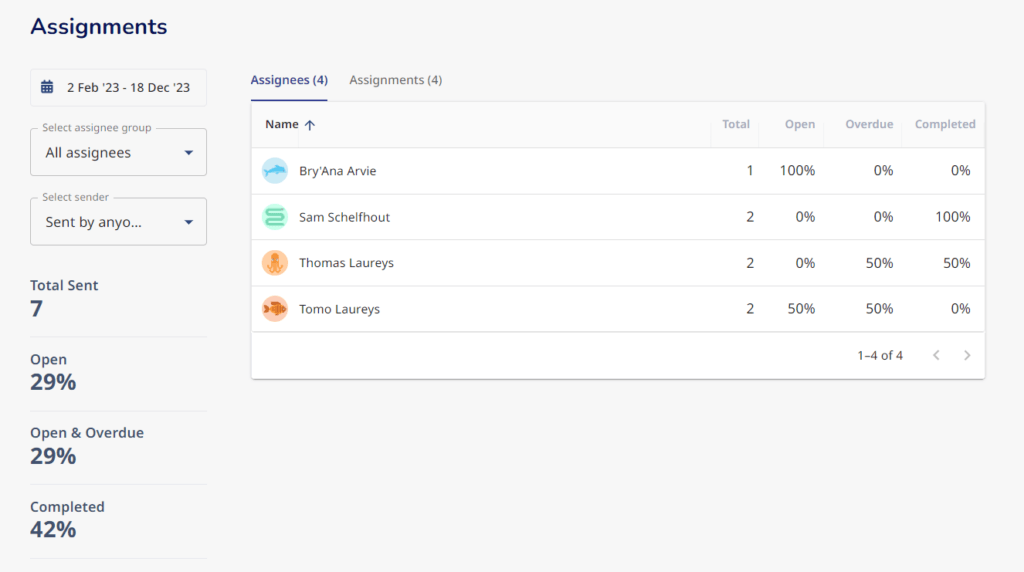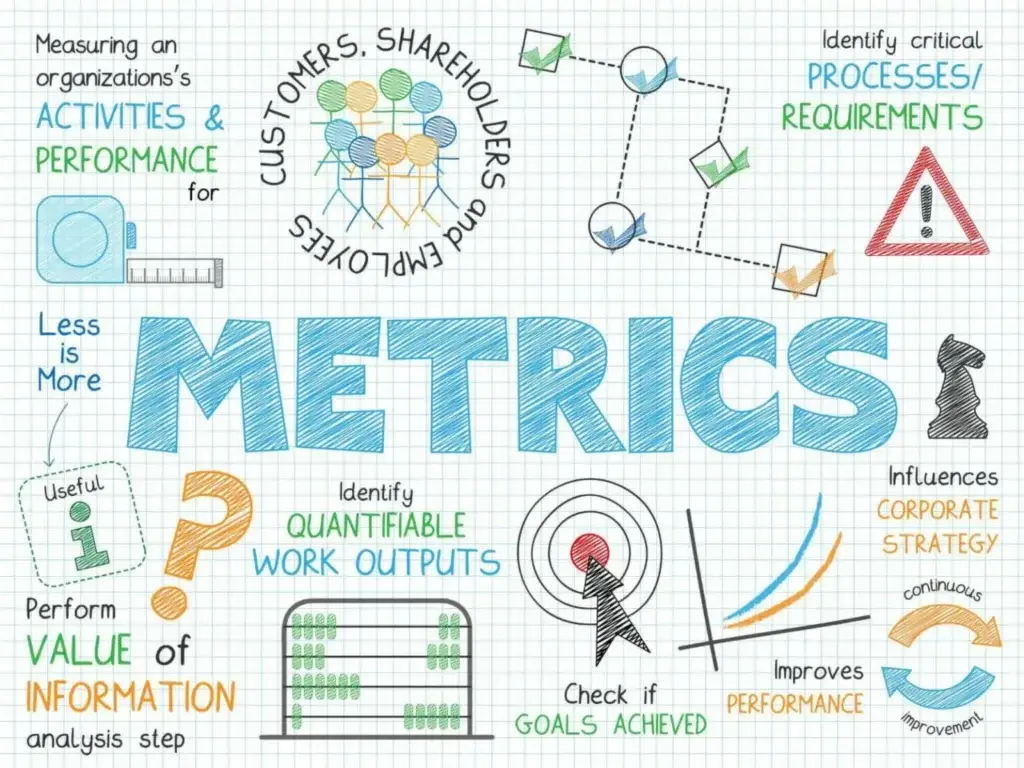Another new year brings with it more fresh opportunities.
No, we’re not talking about that new gym membership you signed up for.
Or the Spanish phrasebook you’ve not opened yet.
No, this new year, we’re talking about business growth metrics 📊
These aren’t just random numbers; they’re like the vital signs of a business, telling us how well it’s doing and where it’s headed.
At the start of a new year, getting a handle on these metrics is like having a roadmap for success. It’s about making smart decisions, setting realistic goals and rocks, and navigating the business journey with confidence.
What are business growth metrics?
Also known as Key Performance Indicators (KPIs), business growth metrics that organizations use to evaluate and measure various aspects of their performance and development. They cover a range of factors, including revenue, customer satisfaction and how well your investments are paying off.
Think of them as your business’s health checkup.
Why are business growth metrics so important?
Business growth metrics play a pivotal role in assessing the health, performance, and future trajectory of a business. Understanding where you are as a business can help you:
Understand your performance
Metrics provide a tangible way to evaluate how well a business is performing, allowing leaders to understand where the company stands in relation to its goals.
Make more informed decisions
Metrics empower decision-makers with data-driven insights. Whether it’s about expanding operations, launching new products, or optimizing marketing strategies, having access to relevant metrics ensures decisions are well-informed and aligned with the overall growth strategy.
Strategically plan ahead
By understanding their current performance, leaders can develop strategic plans that capitalize on strengths, address weaknesses, and position the company for sustainable growth.
Allocate resources
Whether it’s budgeting for marketing campaigns or optimizing workforce distribution, businesses can channel resources where they are most needed, maximizing efficiency and returns.
Improve customer processes
Understanding customer behavior and preferences means you can create tailored strategies and processes that enhance customer loyalty and attract new clients.
Be more adaptable
In a dynamic business environment, adaptability is key to survival. Metrics serve as early warning signs, highlighting areas that may need attention or adjustment.
Motivate your employees

Employees thrive in an environment where their efforts contribute to the success of the company. Metrics, such as employee productivity and retention rates, can be used to recognize and reward high-performing teams, fostering a positive work culture.

What business growth metrics should you be tracking?
Most businesses will have their own ideas of what constitutes growth in their business, and while this often focuses solely on revenue-driving areas, there are a whole heap of other statistics that are just as important to measure.
We’ve listed out the top 8 KPIs which will give you the most accurate picture of how your business is growing below.
1. Business Revenue
Your revenue is all the money that comes into your business, fueling your operations and letting you do all the important things like pay the bills, invest in innovation and reward your staff for their hard work.
Monitoring revenue growth isn’t just a task for the finance department – it’s a strategic move for every business leader. Witnessing a surge in revenue is like hitting the jackpot, but the real art lies in sustaining and amplifying that success. It’s about understanding what products or services are driving that revenue, identifying untapped market segments, and staying agile in response to shifts in consumer behavior.
Revenue isn’t just a metric; it’s what guides you on your business journey. It’s about constantly asking, “How can we make this number higher?” Because, in the end, a healthy revenue stream isn’t just a reflection of past success; it’s a promise of future growth. So, keep an eye on those dollars and cents—they’re more than just numbers; they’re the proof of your business’ evolution.
2. Net Profit (NP)
Net profit is like the magician’s reveal at the end of a trick; it’s what’s left after all the costs, expenses, and financial hocus-pocus have had their say. It’s basically how much of your revenue is actually yours to keep.
Why does net profit matter? Well, it’s a crucial metric because it tells you how efficiently your business is running. It’s not just about making money; it’s about making sure you’re making more money than you’re spending. If your net profit is healthy, it means you’re managing your finances well and have a good chance for future growth. On the flip side, if it’s consistently low or negative, it might be a sign that you need to adjust your expenses or find ways to increase revenue.
3. Return on Investment (ROI)
Your ROI is a measure of how much profit you’ve made in relation to how much you’ve invested in something for your business. Say you’re paying an external team to manage your social media accounts, you’d measure the ROI of that activity with this basic formula:
ROI = (Net Profit from Investment / Cost of Investment) * 100
If your ROI is positive, it means your investment is yielding more than you initially put in. On the other hand, a negative ROI signals that your investment hasn’t generated enough returns to cover its costs.
Tracking the ROI of all your business tools is vital as it helps to guide you on which are worth spending money on, and which might need a shake-up.
It’s worth pointing out that some things are more difficult to track than others.
We actually wrote an article on how you can track the ROI of Whale, and this can be a handy guideline for other tools as well!
4. Customer acquisition cost (CAC)
Customer Acquisition Cost (CAC) is like your business’s receipt for getting new customers. It’s the total amount you spend on marketing, sales, and other efforts to bring fresh new people into your customer list.
The formula is pretty straightforward:
CAC = (Total Marketing and Sales Costs) / (Number of New Customers Acquired).
Keeping an eye on CAC is crucial because it tells you how much it costs to win over each new customer. If CAC is high, it might be time to rethink your strategy or find more cost-effective ways to grow your customer base.
5. Customer lifetime value (CLV or LTV)
Customer Lifetime Value (LTV) is like a crystal ball for your business, helping you predict the future value of a customer.
It’s the total revenue you can expect from a customer throughout their entire journey with your business.
The formula is pretty simple:
CLV = Average Purchase Value × Average Purchase Frequency × Customer Lifespan.
In simpler terms, it tells you how much a customer is likely to spend with you over the entire relationship. Understanding CLV helps you make strategic decisions about how much you can invest to acquire and retain customers while remaining profitable.
6. Employee ramp-up time
Employee ramp-up time is the period it takes for a new hire to reach full productivity and contribute effectively to the wider team.
The duration can vary depending on the complexity of the role and the learning curve associated with the job, but keeping an eye on ramp-up time for your staff is really important to ensure that new hires become valuable team members within a reasonable timeframe.
One of the ways you can support new hires is by offering a smooth onboarding process. In fact, 60% of organizations with structured onboarding processes saw an increase in revenue year-on-year.
Making sure they have everything they need from day one, including training guides, company information and staff lists, can make a huge difference to how quickly they learn about their new role and understand their place in the business.
Want some hints on how to set up a killer onboarding process? We got you.
7. Employee retention rate
Employee retention is a metric that’s often missed off lists like this, but it’s absolutely key for any business to measure. Any HR representative worth their salt will tell you how important it is to retain your staff – it costs, on average, 33% of an employee’s yearly salary when they exit. Not just to save on the costs of recruiting but also to keep knowledge within the business.
Retention is all about keeping your team members happy and motivated so they stick around for the long haul. It’s like maintaining a solid friendship; you want to create an environment where people feel valued and want to stay.
The key metric is the retention rate, which calculates the percentage of employees who stay with the company over a given period. High retention is generally a good sign that your workplace is a happy, productive space. It’s crucial for businesses to understand and improve retention because a stable, satisfied team often leads to better overall performance and company success.
Find out more about calculating savings on employee turnover.
8. Customer satisfaction scores
No matter how well-run your business is, if your customers aren’t happy, it’s not going to work. US companies lose more than $62bn each year due to poor customer service – you don’t want to be one of those.
Customer satisfaction (CSAT) scores are like the report card for how happy your customers are with your products or services. It’s a simple way to measure their contentment.
Typically presented as a percentage or a scale, CSAT reflects the level of satisfaction based on customer feedback. The question often asked is something like, “How satisfied are you with our product/service?”, with respondents giving a score between 0-10.
This score is sometimes referred to as a Net Promoter Score (NPS).
Anyone who answers between 0-6 is a detractor, 7-8 are passives, and 9-10 are promoters. Your NPS is:
% of promoters – % of detractors
This gives you a score between -100% and +100%, with anything in the positive scale considered a good result.
Regularly tracking CSAT helps businesses gauge their performance from the customer’s perspective and identify areas to enhance the overall experience.
Bottom line?
Tracking your business growth metrics isn’t just a wise decision; it’s a strategic imperative for any organization that wants to thrive in the ever-evolving landscape of commerce.
It not only provides immediate insights into your company’s performance now, but also sets the stage for good habits in the future.
It establishes a routine of strategic planning, where teams collaborate to set realistic goals, adapt to market dynamics, and optimize resource allocation. Over time, this practice becomes ingrained in your company’s DNA, fostering an environment of continuous improvement and adaptability.
And don’t forget the most important part – make sure you celebrate every win that comes your way.








